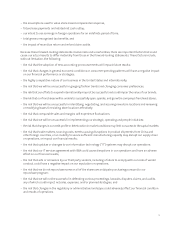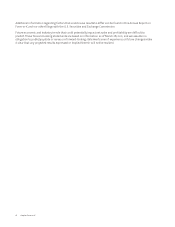Banana Republic 2010 Annual Report Download - page 19
Download and view the complete annual report
Please find page 19 of the 2010 Banana Republic annual report below. You can navigate through the pages in the report by either clicking on the pages listed below, or by using the keyword search tool below to find specific information within the annual report.depend upon various factors, including the demand for our products in new markets internationally and our ability to
successfully identify appropriate third parties to act as franchisees, distributors, or in a similar capacity. In addition,
certain aspects of these arrangements are not directly within our control, such as the ability of these third parties to
meet their projections regarding store locations, store openings, and sales. Other risks that may affect these third
parties include general economic conditions in specific countries or markets, changes in diplomatic and trade
relationships, and political instability. Moreover, while the agreements we have entered into and plan to enter into in
the future provide us with certain termination rights, the value of our brands could be impaired to the extent that
these third parties do not operate their stores in a manner consistent with our requirements regarding our brand
identities and customer experience standards. Failure to protect the value of our brands, or any other harmful acts or
omissions by a franchisee, could have an adverse effect on our results of operations and our reputation.
The market for prime real estate is competitive.
Our ability to effectively obtain real estate to open new stores nationally and internationally depends on the
availability of real estate that meets our criteria for traffic, square footage, co-tenancies, lease economics,
demographics, and other factors, including our ability to negotiate terms that meet our financial targets. We also
must be able to effectively renew our existing store leases. In addition, in recent years, we have been seeking to
downsize, consolidate, reposition, or close some of our real estate locations, which in most cases requires a
modification of an existing store lease. Failure to secure adequate new locations or successfully modify existing
locations, or failure to effectively manage the profitability of our existing fleet of stores, could have a material
adverse effect on our results of operations.
Additionally, the current economic environment may make it difficult to determine the fair market rent of retail
real estate properties within the United States and internationally. This could impact the quality of our decisions to
exercise lease options at previously negotiated rents and the quality of our decisions to renew expiring leases at
negotiated rents. Any adverse effect on the quality of these decisions could impact our ability to retain real estate
locations adequate to meet our targets or efficiently manage the profitability of our existing fleet of stores and
could have a material adverse effect on our results of operations.
We experience fluctuations in our comparable store sales and margins.
Our success depends in part on our ability to improve sales, in particular at our largest brands. A variety of factors
affect comparable store sales, including fashion trends, competition, current economic conditions, the timing of
new merchandise releases and promotional events, changes in our merchandise mix, the success of marketing
programs, and weather conditions. These factors may cause our comparable store sales results to differ materially
from prior periods and from expectations. Our comparable store sales have fluctuated significantly in the past on
an annual, quarterly, and monthly basis as demonstrated by a decrease of 12 percent in fiscal 2008, a decrease of
3 percent in fiscal 2009, and an increase of 1 percent in fiscal 2010. Over the past five years, our reported gross
margins have ranged from a high of 40 percent in fiscal 2009 to a low of 36 percent in fiscal 2006. In addition, over
the past five years, our reported operating margins have ranged from a high of 13 percent in fiscal 2010 to a low of
8 percent in fiscal 2006.
Our ability to deliver strong comparable store sales results and margins depends in large part on accurately
forecasting demand and fashion trends, selecting effective marketing techniques, providing an appropriate mix of
merchandise for our broad and diverse customer base, managing inventory effectively, using effective pricing
strategies, and optimizing store performance. Failure to meet the expectations of investors, securities analysts, or
credit rating agencies in one or more future periods could reduce the market price of our common stock and cause
our credit ratings to decline.
Changes in our credit profile or deterioration in market conditions may limit our access to the
capital markets.
Although we believe our existing cash and cash equivalents combined with future cash flow from our operations
will be adequate to satisfy our business operations needs for the foreseeable future, we may require additional
cash for unexpected contingencies.
12 Gap Inc. Form 10-K
























